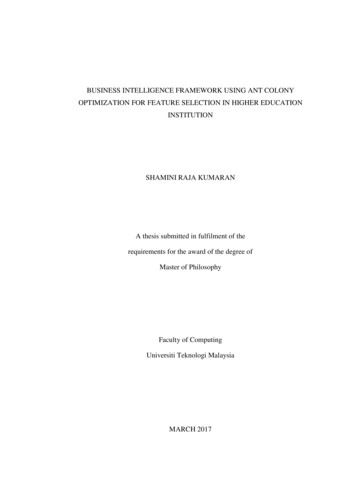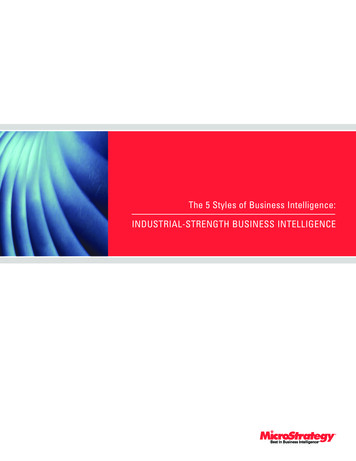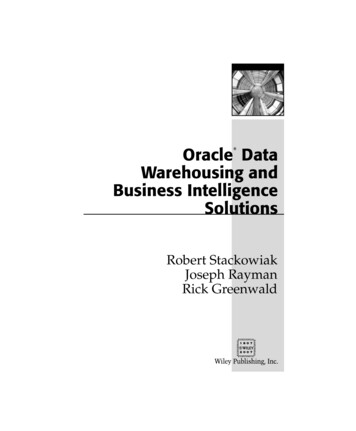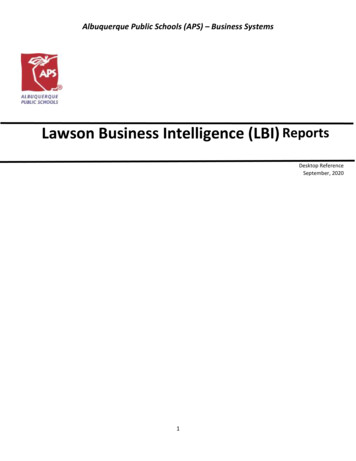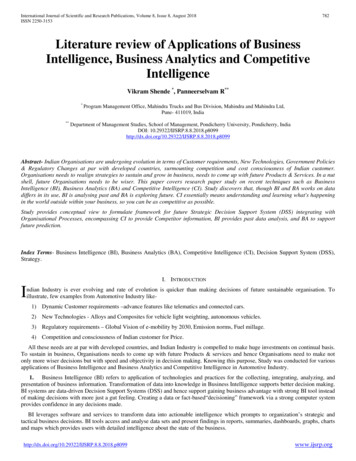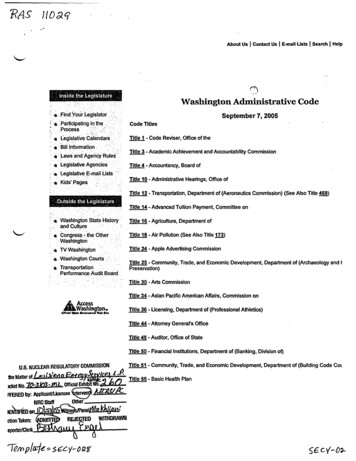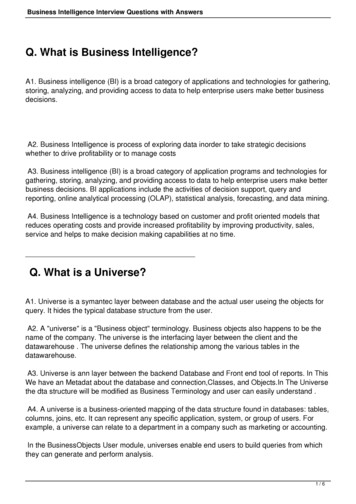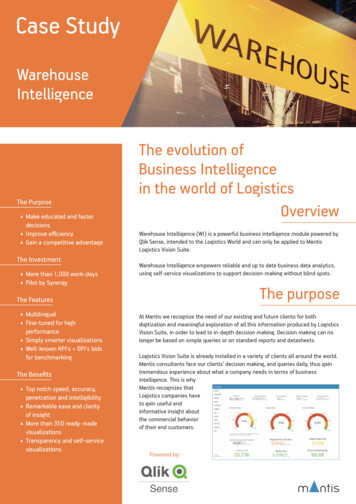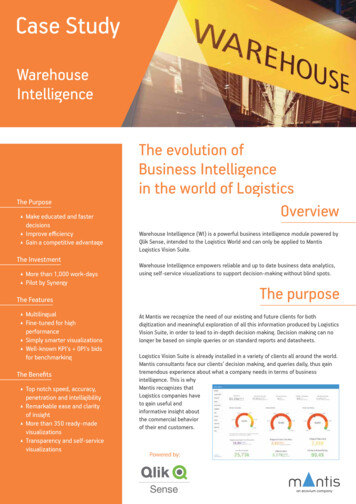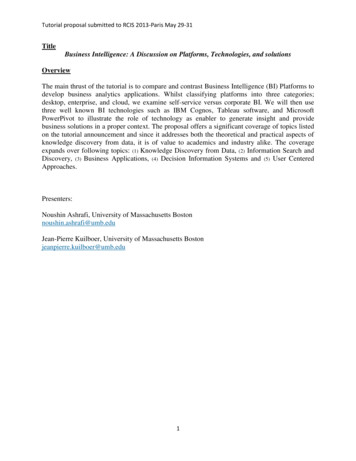
Transcription
Tutorial proposal submitted to RCIS 2013-Paris May 29-31TitleBusiness Intelligence: A Discussion on Platforms, Technologies, and solutionsOverviewThe main thrust of the tutorial is to compare and contrast Business Intelligence (BI) Platforms todevelop business analytics applications. Whilst classifying platforms into three categories;desktop, enterprise, and cloud, we examine self-service versus corporate BI. We will then usethree well known BI technologies such as IBM Cognos, Tableau software, and MicrosoftPowerPivot to illustrate the role of technology as enabler to generate insight and providebusiness solutions in a proper context. The proposal offers a significant coverage of topics listedon the tutorial announcement and since it addresses both the theoretical and practical aspects ofknowledge discovery from data, it is of value to academics and industry alike. The coverageexpands over following topics: (1) Knowledge Discovery from Data, (2) Information Search andDiscovery, (3) Business Applications, (4) Decision Information Systems and (5) User CenteredApproaches.Presenters:Noushin Ashrafi, University of Massachusetts Bostonnoushin.ashrafi@umb.eduJean-Pierre Kuilboer, University of Massachusetts Bostonjeanpierre.kuilboer@umb.edu1
Tutorial proposal submitted to RCIS 2013-Paris May 29-31Abstract;Business intelligence (BI) refers to the organizational ability to integrate data from across the enterpriseand transform them into knowledge. The assimilated knowledge is then used to develop newopportunities towards achieving competitive advantage. BI platforms are used to integrate a full range ofanalytics capabilities, including statistics, predictive analytics, data and text mining, forecasting, andoptimization for faster, more confident decision making. According to Gartneri “Business intelligence(BI) platforms enable enterprises to build BI applications by providing capabilities in three categories:analysis, such as online analytical processing (OLAP); information delivery, such as reports anddashboards; and platform integration, such as BI metadata management and a development environment.”Creating Business intelligence solutions to generate insights to empower decision makers in many facetsof business is facilitated by deploying appropriate platforms and related technologies.This tutorial covers the basics of Business Intelligence and explores BI platforms to launch BIenvironments that advance critical success factors such as agility and fact-based decision makingthroughout organizations. We will distinguish between BI technologies developed by BI vendors and BIsolutions deployed within organizations. We argue that BI solutions utilize BI technologies to draw uponvast amount of data from internal and external sources to provide knowledge for better decision making.We compare and contrast Self- service versus corporate BI and discuss the type of platforms suitable toeach. Self-service BI applications promote users self-reliant, which in turn lessens the burden on IT.Platforms that are specifically designed for multitenant hosting in public or private clouds allow elasticityand less reliance on internal IT resources, but are less flexible and more difficult to customize ii.Technologies and tools provided by Microsoft, Tableau software, and IBM are some examples of selfservice BI.Corporate BI, on the other hand, involves integrated enterprise-wide computing technologies and servicesfor complex high-performance computing environments. Corporate BI applications are developed usingenterprise data centers or private, public and hybrid clouds. Some built upon open standards that securelydeliver a complete range of business intelligence that embraces cloud efficiencies and cost savings toachieve marketplace advantage. One example of Corporate BI platform is IBM Cognos that deliversthe capabilities on a single service-oriented architecture (SOA) and produces reports, analysis,dashboards and scorecards to monitor business performance, analyze trends and measure results.The tutorial will guide participants through implementation of BI using three different widelyused Business intelligence solutions such as Cognos by IBM, Powerpivot by Microsoft, andTableau software. These tools vary in their level of sophistication, ease of use, capabilities, andprice and each is appropriate for particular business needs. For example Microsoft Powerpivot isuseful in scenarios where users want to build their own models. For the vast majority of users,who are not interested in or capable of doing this, there is tableau software with pre-framedmodels that give users the ability to run ad hoc queries and build their own reports withoutneeding to know how to model the data they use. Corporate BI, on the other hand, depends uponrunning scheduled, web-based or printed reports and sending them out to a large user base that2
Tutorial proposal submitted to RCIS 2013-Paris May 29-31don’t have the time or know-how to query via a PivotTable, let alone build a PowerPivotmodeliii.We will discuss an overview of what can be accomplished with BI and how users caninteractively create and share custom applications, dashboards and visualizations to help solveindividual and workgroup challenges. We will show how these BI tools enable self-sufficientconstruction of digital dashboards to display metrics in tables, charts, graphs, maps, colors, andspeedometers in a customized interface and a navigable layout. The goal of the tutorial is toempower users to independently explore, analyze, visualize and share data without relying on ITfor assistance, in minutes, information workers can generate insights while experiencing greaterfreedom and flexibility.Our tutorial will benefit academics who are interested in the methods of knowledge discovery ofdata from various sources and formats and educators who are interested in incorporating some orall of these tools in their BI courses. Since “turning that data into meaningful information toimpact performance” is the goal of any organization, this tutorial has clear applicability toindustry where training employees to enable self-sufficiency with the new technology is a toppriority.ScopeThe tutorial provides important background information about business intelligence and focuseson platforms for building business intelligence applications and touches upon. Topics includedare: What is Business IntelligenceBusiness Intelligence Platforms; types, capabilities, Pros and ConsSelf-service versus corporate business intelligence applications.Business Intelligence Solutions for types of platformsDemonstration of platforms, technology, and solutionsIn particular the tutorial is designed to guide users to discover knowledge from data via creating: Reports that equip users with the information they need to make fact-based decisions. Dashboards that help users access, interact and personalize content in a way thatsupports how they make decisions. Analysis capabilities that provide access to information from multiple angles andperspectives to facilitate analyzing and making informed decisions. Collaboration capabilities that fuel the exchange of ideas during the decision-makingprocess. Scorecarding capabilities that automate the capture, management and monitoring ofbusiness metrics to help compare them with strategic and operational objectives.The materials covered in this tutorial have applicability to a number of topics of interest toparticipants of Conference on Research Challenges in Information Science such as3
Tutorial proposal submitted to RCIS 2013-Paris May 29-31Knowledge Discovery of Data, Decision Information Systems, Information Search andDiscovery, and Business ApplicationsBackground of the attendeesThe requirements for attendees are minimal. Anybody with interest in learning BusinessIntelligence tools and platforms will benefit from the tutorial. Individuals who are familiar withexcel will have an easier time to follow MS powerpivot. Tableau and Cognos will be taughtassuming that the attendees have no experience with these technologies.Which material will be provided to attendees;We will provide PowerPoint slides, printed hand-outs and links to training videos, access to theBI software applications, real world examples, and data sets.Timetable. 90 minutes Table of content and Introduction (5 minutes) BI concepts and product landscape( 5 minutes) Corporate versus Self-service business Intelligence (10 minutes) BI platforms to develop business applications (15 minutes)o Desktop - Microsoft Powerpivot (15 minutes)o Desktop or Cloud –Tableau Software (15 minutes)o Desktop, Enterprise, or Cloud- IBM Cognos (15 minutes) Future of BI and conclusion: 10 minutes.Demonstration of BI technologies are short and given the time constraint are not complete, butwe will provide the audience with enough materials that they can continue to practice and learnas much as they wish on their own time and leisure. The training materials used in the tutorial arealready tested in graduate classrooms and proven to be very useful.4
Tutorial proposal submitted to RCIS 2013-Paris May 29-31A short bio of the presenters;1. Noushin Ashrafi is a Professor of Management Information Systems at the University ofMassachusetts-Boston. Her areas of expertise are in Business Intelligence, ObjectOriented System Analysis and Design, Strategic Organizational Agility. She hasnumerous journal publications and is the author of “Object Oriented System Analysis andDesign”, 2009. She has conducted seminars in organizational agility/businessintelligence in the U.S.A and abroad. She was Fulbright Scholar in 2010-2011 and therecipient of IBM Healthcare Industry Skills Innovation award in 2010 and IBM Watsonsolution in 2012. Dr. Ashrafi has developed graduate curriculum in Business intelligenceand has taught BI courses, which include deployment of platforms for developingbusiness analytics. She received her Ph.D. and M.B.A. Degrees from the University ofTexas and her B.A. from SUNY.2. Jean-Pierre Kuilboer is an Associate Professor in the Management Science andInformation Systems Department at the University of Massachusetts Boston. Dr.Kuilboer’s current research interests are in the area of database management, data miningand data warehousing, and network security and privacy. Dr. Kuilboer is the author of“E-Business & E-Commerce Infrastructure: Technologies Supporting the E-BusinessInitiative” and has a vast industrial experience in Europe and the United States. He is alsoinvolved in a number of initiatives such as strategic planning, academic computingadvisory, and the Massachusetts advanced cyber security center. Dr. Kuilboer receivedhis Ph.D. from the University of Texas and his B.A. from University of Louisiana.iGartner, 2012iiBoris Evelson, The Forrester Wave : Self-Service, Business Intelligence Platforms, Q2, June 12, 2012www.activereportsserver.com, Dec. 2012iii5
Business Intelligence: A Discussion on Platforms, Technologies, and solutions Overview The main thrust of the tutorial is to compare and contrast Business Intelligence (BI) Platforms to develop business analytics applications. Whilst classifying platforms into three categories; desktop, enterprise, and cloud, we examine self-service versus .
